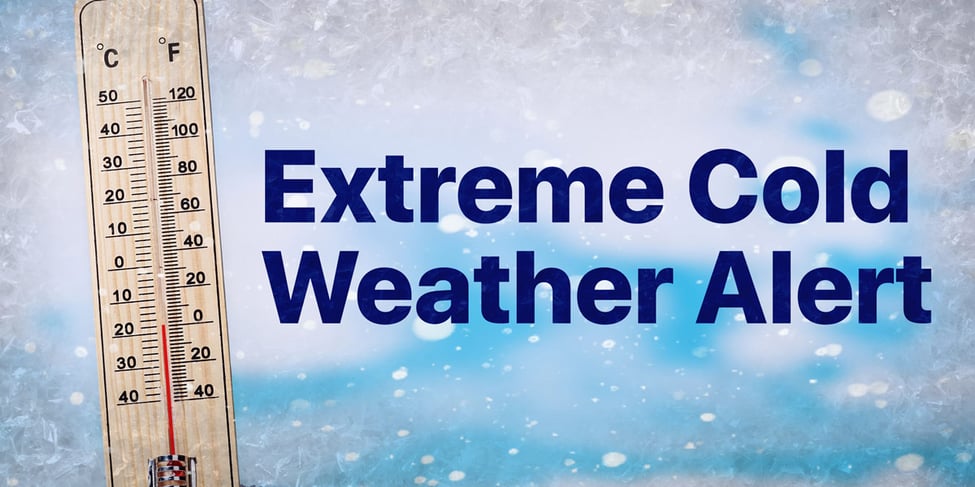A polar vortex can wreak havoc on our life here in Alberta. These extreme weather events are not very common or often, but when the temperatures plummet to -50 degrees Celsius, they certainly test our homes. It is critical to know what you can do to protect your biggest investment.
- Ice Buildup on Windows and Doors
You will almost certainly notice ice on your windows and doors. This is caused by the condensation from the frigid outside air meeting your warm indoor air. The condensation freezes and creates ice on the bottom corners of your windows and doors.
The best way to deal with this is to eliminate any additional moisture in your home.
Tips
1. Turn off your whole-home humidifier (if you have one, it's connected to your furnace).
2. Run your whole-home ventilation fan. Typically, there is a wall switch near your thermostat. This will turn your furnace fan as well as your second floor bathroom fan. The furnace fan will help circulate all the air in your home, and the upstairs fan will help expel humidity from your home.
3. Run your bathroom fans. This is especially important after a shower or bath for a minimum of one hour.
4. Purchase a small dehumidifier. You can get them for about $200-500, and they do an incredible job of reducing your humidity.
5. If you have blinds on your windows, leave a gap of about 2 inches from the bottom. This will allow warm air from your furnace to reach the windows and prevent ice buildup.
- Protecting Door Knobs and Locks
Frozen door knobs and locks can leave you stranded outside or inside your home.
Tips
1. If your locks are frozen, use a de-icer spray designed for frozen locks. Spray it directly into the keyhole. Do not use WD-40 or any other lubricant, as general lubricants can freeze, making matters worse.
2. Safely warm the locks with a towel soaked in warm water.
3. Do not apply boiling water or direct heat to it.
4. Use your key to lock and unlock your door every so often to keep it moving and working well.
3. Furnace Maintenance
One of the worst things that can happen during an extreme cold snap is if your furnace stops working. You must pay close attention to your furnace's intake and exhaust pipes on the side of your home.
These pipes are typically about 2 to 3 feet off the ground and white or black in colour. The exhaust expels warm air, creating a slow condensation drip, which creates icicles. If you are not diligent in removing them, it will reduce your airflow and trigger your furnace to shut off for safety reasons.
Tips
1. Check the exhaust pipes daily. Remove any ice from these pipes, as well as similar pipes from your hot water heater. If you notice that ice is building up on the inside and starting to narrow the hole, use a heat gun (at a careful distance) to melt it.
2. Make sure you change your furnace filters regularly. If the furnace is struggling to push air though a dirty filter, it will shut off. Changing the furnace filter could get it working again.
4. Use Window Coverings
Window coverings can do wonders to help keep your home's temperature consistent.
Tips
1. Keep window coverings and curtains closed (except for the bottom few inches).
2. Combining blinds and curtains will have the greatest effect on reducing heat loss from your windows.
3. Honeycomb blinds have air pockets which trap warm air. These are very energy efficient for all seasons, and actually have an R-value of between 4-7. I've installed ones by Cochrane Quality Blinds in my home and I have been very, very happy with the result.
5. General Tips for Dealing with the Extreme Cold
1. Keep Doors Closed As Much As Possible
Every time you open the door, frigid air will rush into your home. The less you open the doors, the less your furnace turns on.
2. Seal Any Drafts
Look for any gaps or cracks in doors and windows. Either add weatherstripping or caulking if you feel any drafts. Check for drafts around electrical outlets, too, and use outlet gaskets to minimize heat loss.
3. Ice Build up on Electrical Outlets or Receptacles?
This is likely caused by insufficient insulation or the wrong box was used. Pull out the outlet, ensure that a proper airtight box is installed, and that there is insulation in that area.
4. Proper Attic Insulation
You'll need a professional opinion to know if your current attic insulation is enough. You can add more insulation, if necessary.
Ensure that the attic hatch has weatherstripping around it, and that the hatch itself is properly insulated.
5. Keep Your Car's Gas Tank Full
Extreme cold weather events can shut down gas stations if the pumps freeze. Don't leave yourself stranded.
6. Block Heaters
These are very helpful for preventing your car battery from dying. However, it is VERY important that the extension cord you use is 16 gauge and rated for outdoor winter use.
Do NOT use your block heater if you park in the garage. Not only does it use a lot of energy, it is not necessary if the car is not outside. The most important reason is if the extension cord is damaged, it could lead to a fire.
Don't have a block heater? You can use a plug-in Electric Battery Blanket, like This one from Canadian Tire, and it will do the trick.
Stay warm, and stay safe!

